 Chinese in San
Francisco
Chinese in San
Francisco
California Gold Rush
|
THE CHINESE
by Henry Kittredge Norton
Like every other nation in the world, the Chinese Empire was represented
in the great rush for California which took place during the gold excitement.
At the beginning of the year 1849 there were in the state only fifty-four
Chinamen. At the news of the gold discovery a steady immigration commenced
which continued until 1876, at which time the Chinese in the United States
numbered 151,000 of whom 116,000 were in the state of California. This
increase in their numbers, rapid even in comparison with the general increase
in population, was largely due to the fact that previous to the year 1869
China was nearer to the shores of California than was the eastern portion
of the United States. Another circumstance which contributed to the heavy
influx of Chinese was the fact that news of the gold discovery found southeastern
China in poverty and ruin caused by the Taiping rebellion. Masters of vessels
made the most of this coincidence of favorable circumstances. They distributed
in all the Chinese ports, placards, maps and pamphlets with highly colored
accounts of the golden hills of California. The fever spread among the
yellow men as it did among others, and the ship-men reaped a harvest
from passage money.
Probably the most conspicuous characteristic of the Chinese is their
passion for work. The Chinaman seemingly must work. If he cannot secure
work at a high wage he will take it at a low wage, but he is a good bargainer
for his labor and only needs the opportunity to ask for more pay. This
is true of the whole nation, from the lowest to the highest. They lack
inventiveness and initiative but have an enormous capacity for imitation.
With proper instruction their industrial adaptability is very great. They
learn what they are shown with almost incredible facility, and soon become
adept.
If the social conditions prevailing in California in the days of ’49
are recalled, it is not difficult to realize how welcome were the Chinese
who first came to the country. Here were men who would do the drudgery
of life at a reasonable wage when every other man had but one idea—to
work at the mines for gold. Here were cooks, laundrymen, and servants ready
and willing. Just what early California civilization most wanted these
men could and would supply.
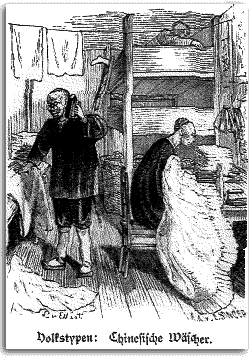
The result was that the Chinaman was welcomed; he was considered quite indispensable. He was in demand as a laborer, as a carpenter, as a cook; the restaurants which he established were well patronized; his agricultural
endeavors in draining and tilling the rich tule lands were praised. Governor
McDougal referred to him as “one of the most worthy of our newly adopted
citizens.” In public functions he was given a place of honor, for
the Californians of those days appreciated the touch of color which he
gave to the life of the country. The Chinese took a prominent part in the
parades in celebration of the admission of the state to the Union. The
Alta California, a San Francisco newspaper, went so far as to say,
“The China Boys will yet vote at the same polls, study at the same
schools, and bow at the same altar as our countrymen.” Their cleanliness,
unobtrusiveness and industry were everywhere praised.
The Chinese were surely in a land of milk and honey. They had left
a land of war and starvation where work could not be had and food must
be begged and here they found themselves in the midst of work and plenty.
They were everywhere welcomed and their wages were such that they could
save a substantial part to send back to the families they had left at home
in China; or, if they did not wish to labor for masters, they could go
to the mines. Here they could take an old claim which had been abandoned
by the white miner and dig from it gold dust which to them represented
wealth untold. They were careful not to antagonise these whites by prospecting
ahead of them, and in return they received the same treatment in the mining
districts that they had met with in San Francisco.
The Chinaman was welcomed as long as the surface gold was plentiful
enough to make rich all who came. But that happy situation was not long
to continue. Thousands of Americans came flocking in to the mines. Rich
surface claims soon became exhausted. These newcomers did not find it so
easy as their predecessors had done to amass large fortunes in a few days.
California did not fulfil the promise of the golden tales that had been
told of her. These gold-seekers were disappointed. In the bitterness
of their disappointment they turned upon the men of other races who were
working side by side with them and accused them of stealing their wealth.
They boldly asserted that California’s gold belonged to them. The cry of
“California for the Americans” was raised and taken up on all
sides.
Within a short time the Frenchman, the Mexican and the Chileño
had been driven out and the full force of this anti-foreign persecution
fell upon the unfortunate Chinaman. From the beginning, though well received,
the Chinese had been a race apart. Their peculiar dress and pigtail marked
them off from the rest of the population. Their camps at the mines were
always apart from the main camps of white miners. This made it the easier
to turn upon them this hatred of outsiders. With the great inrush of gold-seekers
the abandoned claims which the Chinese had been working, again became desirable
to the whites and the Chinese were driven from them with small concern.
Where might made right the peaceable Chinaman had little chance.
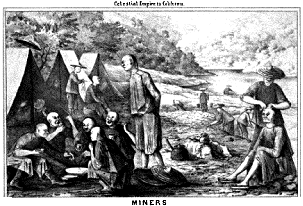
The state legislature was wholly in sympathy with the anti-foreign
movement, and as early as 1850 passed the Foreign Miners’ License law.
This imposed a tax of twenty dollars a month on all foreign miners. Instead
of bringing into the state treasury the revenue promised by its framers,
this law had the effect of depopulating some camps and of seriously injuring
all of them. San Francisco became overrun with penniless foreigners and
their care became a serious problem. The law was conceded to be a failure
and was repealed the following year.
By
the time this was done, however, the Chinese had become the most conspicuous
body of foreigners in the country and therefore had to bear the brunt of
the attacks upon the foreign element. Governor Bigler suddenly became inspired
with the realization of the value of an attack upon them as a political
asset. He sent a special message to the legislature in which he charged
them with being contract “coolie” laborers, avaricious, ignorant
of moral obligations, incapable of being assimilated, and dangerous to
the public welfare. The result was a renewal of the foreign miners’ tax,
but in a milder form than its predecessor.
This did not satisfy the miners, who were at that time the strongest
body, in the community, and the next year the tax was again made prohibitive.
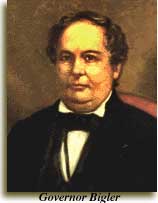
But it was not only the miners who hated the Chinese. The yield of
the placers began to decline in 1853-4, and the discovery of gold in Australia
brought on a financial panic in the latter year. Prices, rents and values
fell rapidly and many business houses failed. There were strikes for higher
wages among laborers and mechanics though the prevalent rate for skilled
labor was ten dollars per day and for unskilled three dollars and a half.
Investors became alarmed and, withdrew their capital. Thousands of unsuccessful
miners drifted back into San Francisco and began to look for work at their
old time occupations. The labor market was glutted and an enormous number
were out of work.
To these unemployed men the presence of thousands of Chinese, thrifty,
industrious, cheap, and above all, un-American, was obviously the
cause of their plight. The cry was raised that the large number of Chinese
in the country tended to injure the interests of the working classes and
to degrade labor. It was claimed that they, deprived white men of positions
by taking lower wages and that they sent their savings back to China; that
thus they were human leeches sucking the very life-blood of this country.
Whoever came to their defense was immediately accused of having mercenary
motives or of being half-witted.
The “coolie” fiction of Governor Bigler was seized upon.
In the first half of the nineteenth century a pseudo-slave trade had
sprung up in transporting Chinese laborers under contract to work at a
certain wage for a certain period to Cuba, and parts of South America.
Such laborers were ignorantly called “coolies” by those who were
not familiar with the Chinese language. The word itself comes from two
Chinese words, “koo” meaning to rent, and “lee” meaning
muscle. The coolies are those who rent out their muscles, that is, unskilled
laborers. In the four classes of China they rank with the third, being
considered a higher class than the merchants but below the scholars and
farmers. The word in no way signifies any sort of bondage. The “coolies”
are perfectly free just as our own laborers are.
The Chinese who came to California were largely of this class and so
described themselves on their arrival. It did not take long for the anti-Chinese
agitators to define a “coolie” as a contract laborer and to describe
how he was bound to a master in China to work a certain number of years
at a small wage and how this terrible system was eating the very vitals
out of American labor. This American labor about which there was so much
concern was almost wholly composed of Irish and other European aliens who
were no more American than the Chinese. But they had a vote in prospect.
The Chinese did not.
While the success of the coolie fiction was largely due to the fact
that there were so many who wanted to believe it, a number of circumstances
combined to give it greater vitality. Most of the business transactions
of the Chinese were done through their benevolent organizations which came
to be locally known as the “Six Companies.” The Companies often
contracted for large bodies of laborers and this fact led the unthinking
to conclude that these laborers were under contract with the Six Companies
to work for them as they should direct. This was not the true situation.
These Companies simply acted as clearing-houses for all sorts of transactions
among the Chinese, as they had found that they could handle things in a
strange land more satisfactorily through such associations than they could
individually.
Another thing which strengthened the coolie fiction was the manner
in which the Chinese were employed on the construction work. of the Central
Pacific Railroad. Because of the scarcity of labor the men in charge of
this construction work had sent an agent to China to secure Chinese laborers.
In order to get these men over to this country, it was necessary to advance
their passage-money and other expenses. To cover this loan each Chinaman
so employed signed a promissory note for $75. This note provided for monthly
instalment payments running over a period of seven months and was endorsed
by friends in China. Each laborer was guaranteed a wage of $35 a month.
This financial arrangement was of course seized upon and made much of by
the anti-Chinese agitators as the final proof of “coolieism.”
The belief that the Chinese were contract laborers was one of those
unfortunate errors which sometimes became current in our civic life, and
by frequent repetition receive almost universal acceptance. In the present
instance this phantom of Chinese slavery became so thoroughly a part of
the political life of the Pacific Coast that no attempt was made to reach
the truth of the matter. Every man in public life was under so binding
a necessity to accept the popular belief in regard to the Chinese and to
truckle to it at every turn, that for one to seek the real truth of the
matter was to end forthwith his political career.
In the years following 1854 this unthinking, prejudiced, anti-Chinese
movement ran riot. Various schemes were proposed for ridding the country
of the Chinese as if they were a pest. It was seriously suggested that
they be all returned to China, but as this would have involved an expense
of about seven millions of dollars and ten or a dozen ships for every vessel
that was available, it was reluctantly laid aside. This scheme failing,
it was asserted that they could at least be driven from the mines. But
as this would have deprived the state of a large revenue from licenses
and would have crowded the outcasts in still greater numbers to the cities
and agricultural districts, this too was abandoned.
Various local authorities passed legislation intended to harass them.
Most of the Chinese were in San Francisco, so the principal efforts were
made in that city, The famous “pig-tail ordinance” required
all convicted male prisoners to have their hair cut within one inch of
their heads. This particular piece of idiocy was vetoed by the mayor but
others almost as vicious were passed.
Many of these were declared unconstitutional by the courts, but even
the courts were not at all times consistent friends of the Chinaman. The
worst blow which they received was embodied in a decision given by the
Chief Justice of the state Supreme Court. There was a statute on the books
which prohibited “negroes and Indians” from testifying against
a white man in the courts of the state. The court held, in a brilliantly
logical opinion, that this included the Chinese for the reason that in
the days of Columbus all of the countries washed by Chinese waters had
been called “Indian.”
During the Civil War other issues overshadowed the Chinese question
and the Orientals had a brief respite. But in 1868 the Burlingame treaty
was entered into between the United States and China. It provided for reciprocal
exemption from persecution on account of religious belief, the privilege
of schools and colleges, and in fact it agreed that every Chinese citizen
in the United States should have every privilege which was expected by
the American citizen in China. Though naturalization was especially excepted,
the provisions of this treaty aroused a storm of antagonism on the Pacific
Coast. The labor agitators decried the treaty as a betrayal of the American
workingman, and the whole Chinese question was up again in more violent
form than ever before.
The panic of 1873 and its ill effects brought the matter sharply before
the public and especially that portion of it that was out of work. The
crisis was averted for the time, however, by the opening of the Consolidated
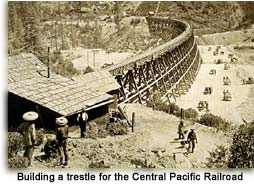 Virginia mines in Nevada and the local wave of prosperity which followed.
But in 1877 the bottom fell out of the whole western business world and
brought back the old agitation with tenfold violence. It was made worse
by the always apparent fact that the Chinese were the last to join the
unemployed. In fact they seldom joined at all. Gardening, farming, laundering,
cooking and housework were almost monopolized by them. The railroads employed
thousands of them and they were engaged to some extent in manufacturing. Virginia mines in Nevada and the local wave of prosperity which followed.
But in 1877 the bottom fell out of the whole western business world and
brought back the old agitation with tenfold violence. It was made worse
by the always apparent fact that the Chinese were the last to join the
unemployed. In fact they seldom joined at all. Gardening, farming, laundering,
cooking and housework were almost monopolized by them. The railroads employed
thousands of them and they were engaged to some extent in manufacturing.
This was more than could be borne by the much-oppressed laboring
man, who claimed that the Chinese, were robbing him of his bread and, which
was worse, the only one who benefitted by their labor was that other arch-enemy
of the laboring man, the capitalist. Something must be done. The courts
had annulled the efforts of their municipal authorities and legislatures
when these had tried to help them; Congress had thrown them but a stone;
the treaty-making power had betrayed them; they must take matters
into their own hands. And this they proceeded to do.
Their method of procedure was in most cases to sack and burn the Chinese
laundries and other commercial establishments operated by the Orientals.
It was left for Los Angeles to furnish the most terrible example of all.
Here nineteen Chinamen were hanged and shot in one evening. The massacre
was accompanied by the theft of over $40,000 worth of their goods.
It was in the south in fact that the violent opposition to the Chinese
had first found strong supporters. Here were many who were accustomed to
assert the “superiority” of their race and to attach the idea
of servitude to all inferior races. To work at all was well-nigh intolerable,
but to work beside a “pig-tail” upon whose wearer even
the wild Indian looked down, was to abasing to be borne. From these southerners
this feeling rapidly spread among the immigrants from the poorer countries
of Europe, who at home were in a position almost of servitude. Arrived
in this country and endowed with the rights of citizenship, for which they
are utterly unfitted, they immediately seek to raise themselves higher
in their own estimation by trampling underfoot the rights of others.
But, beside these prejudices due to race-feeling and ignorance,
there were real causes of discontent against the Chinese. They were not
given to sexual immorality themselves but some of them engaged in the business
of importing women whom they would prostitute to others for gain. Gambling
was an all-prevalent vice. These two features of the Chinese situation
received far more emphasis even among thoughtful people than should have
been given to them. This came about because of the practice of “seeing
Chinatown,” which like “seeing the world” too often meant
seeing the worst possible side of it. The proportion of prostitutes among
the Chinese was little if any higher than among the other races in California
at the time but much publicity spread the idea of great numbers. Gambling,
too, while very generally indulged in by the Chinese, was never among themselves
the vice which was made of it by the Americans who frequented the Chinese
houses. The Chinaman gambled for small stakes as an amusement and never
to his own destruction. But while gambling and immorality have been
over-emphasized,
one charge remains against them in all its original strength. The Chinese
quarter was very unclean. Their cleanly persons and spotless linen were
in strange contrast to their filthy homes, overrun as they were with rats
and other vermin.
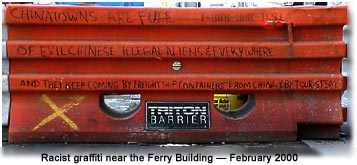 Evil as were these characteristics of the Chinese, they were never
a sufficient excuse for the outrages that were perpetrated upon them. These
bore no relation to the real grievances, but were in a large measure the
unreasoning acts of irresponsible men who were for the most part aliens
themselves. Calmly handled, the Chinese question never would have caused
a disturbance in California. In connection with a violent race hatred,
it kept the state in turmoil for the first thirty years of its existence.
Even today it occasionally recurs to furnish capital for politicians who
are unable to find any other issue. Of late years, however, it has been
very largely superseded in this role by the
Japanese question. Evil as were these characteristics of the Chinese, they were never
a sufficient excuse for the outrages that were perpetrated upon them. These
bore no relation to the real grievances, but were in a large measure the
unreasoning acts of irresponsible men who were for the most part aliens
themselves. Calmly handled, the Chinese question never would have caused
a disturbance in California. In connection with a violent race hatred,
it kept the state in turmoil for the first thirty years of its existence.
Even today it occasionally recurs to furnish capital for politicians who
are unable to find any other issue. Of late years, however, it has been
very largely superseded in this role by the
Japanese question.
In: The Story of California From the Earliest Days to the Present,
by Henry K. Norton. 7th ed. Chicago, A.C. McClurg & Co., 1924.
Chapter XXIV, pp. 283-296.
Return to the top of the page.
|